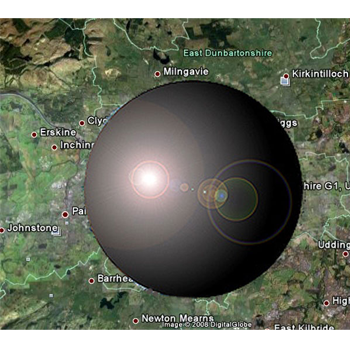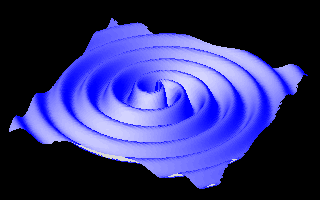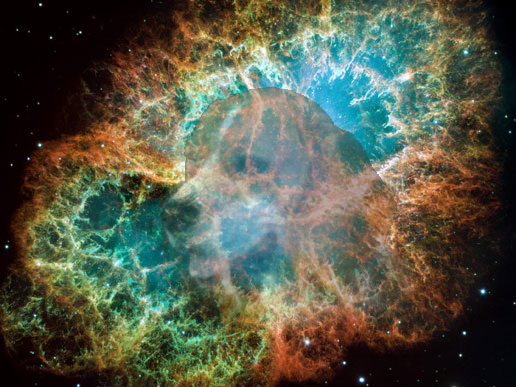Science news
30 May 2008 16:28:00 BST
A rippling yarn

There is a famous detective story in which the hero, Sherlock Holmes, is able to solve a mystery because a dog doesn't bark in the night. Science is like that sometimes. We can learn almost as much from things that don't happen as from something that does.
So when a team of scientists searching for gravitational waves given off by the Crab Nebula found none at all, they weren't too disappointed.
Something from nothing
Ripples in space-time caused by a catastrophe like the collapse of a star have never yet been detected. But scientists have been searching, with more and more sensitive instruments, for forty years. So there will be great excitement when these gravitational waves are finally found. It will open a whole new window on the universe. It will also be one more test passed by Einstein's general theory of relativity.
But the Crab that isn't waving – like the dog that didn't bark – can still tell science detectives a great deal.
"It means for one thing that the neutron star at the heart of the Crab Nebula is an almost perfect sphere, with hardly any irregularities," says the University of Glasgow's Graham Woan. He is co-leader of an international group of scientists that have been looking for traces of gravitational waves in the data from LIGO – the Laser Interferometer Gravitational-Wave Observatory .
Inside the Crab
The Crab Nebula is the remains of a huge star that blew itself to bits almost seven and a half thousand years ago. How do we know? Well according to Chinese documents written at the time, in the summer of 1054 a star appeared in the sky so bright it could be seen in daylight.
This "guest star" slowly faded. But it could still be seen at night for almost two years after it first appeared. There was no explanation at the time, but scientists now know that the guest star was a supernova. This is the explosion at the end of a large star's life, when it has used up all the fuel it needs to shine brightly. The star collapses, then the outer layers bounce back out again from the small, hard centre and splatter themselves all over the neighbourhood.
What remains right at the centre of where the star once was is a small, very dense ball of matter. #a5A teaspoonful of this matter weighs as much as all the ships on Earth. This is a neutron star.
Crab with a pulse
 Compared to normal stars, a neutron star is tiny. If a giant hand placed the Crab neutron star gently in the middle of Glasgow, its outer limits wouldn't go further than the rough circle formed by Milngavie, Kirkintilloch, East Kilbride, Newton Mearns, Paisley and Clydebank.1 That's a pretty small star by any standards.
Compared to normal stars, a neutron star is tiny. If a giant hand placed the Crab neutron star gently in the middle of Glasgow, its outer limits wouldn't go further than the rough circle formed by Milngavie, Kirkintilloch, East Kilbride, Newton Mearns, Paisley and Clydebank.1 That's a pretty small star by any standards.
But it packs a terrific punch.
Neutron stars spin – just as the Earth, planets, sun and stars all spin. But while the Earth spins on its axis once a day, the Crab neutron star spins 30 times a second.
How do we know? Because like many neutron stars it sends out radio waves that sweep across the sky like lighthouse beams and can be detected here on Earth as radio pulses. Thirty pulses a second in the case of the Crab. Neutron stars that give off pulses have a special name. They are called pulsars.
Spin down
Pulsars spin at phenomenal speeds – the fastest so far found spins 716 times a second. But they don't spin forever. From the time a pulsar is born, spinning rapidly in a supernova, it starts to slow down.
A spinning object slows down by giving off energy. The more energy it gives off, the more it slows down. Tops stop spinning 2 as their energy is changed into heat through friction. The Crab pulsar, as we'll see, is losing energy in different ways from a top. But the effect is the same - it slows down.
From the rate a spinning object slows down we can work out how much energy it's giving off (if we know its mass and shape). Scientists have done the sums for the Crab pulsar. They've observed that each second it slows down by just over a third of a thousand millionth of a revolution per second (3.7×10−10 revs per second to be exact).
Braking energy
This sounds pretty puny. It amounts to just a hundredth of a second in a year. But it's an unusually high rate of slowing down for a pulsar. So the Crab is "radiating energy at a prodigious rate," says Woan.
How much energy? Well the sums show that to spin down by just a hundredth of a second a year the Crab pulsar must be sending out 4.4×1031 joules of energy every second.
This is way beyond any amount of energy we're used to here on Earth. It is a thousand million million times as much energy as the whole world uses in electricity in a year.
Spin-down limit
 Now if all this energy were coming off the Crab pulsar as gravitational waves, the scientists would be able to see it in their LIGO measurements.
Now if all this energy were coming off the Crab pulsar as gravitational waves, the scientists would be able to see it in their LIGO measurements.
But they know before they measure anything that it can't all be coming off as gravitational waves. There's an awful lot going on in the Crab Nebula and most of it is powered by energy from the pulsar. This energy is coming off the pulsar as electromagnetic radiation or fast-moving particles.
The best estimate until now of how much energy these two mechanisms carry away from the pulsar was at least 60% of the total spin-down energy (the 4.4×1031 joules per second) of the pulsar. That still meant that gravitational waves might be carrying away 40% of this total energy.
But the new results from the LIGO team show that they aren't. Nowhere near it. The new measurements and analysis are so good that if gravitational waves were carrying away more than 4% of the spin-down energy, the LIGO team would be able to see them in their data. And they can't. Not a trace.
Lot of balls
What the team has achieved with this new research is to set an upper limit on the amount of energy the Crab pulsar can be giving off as gravitational waves. The small size of this limit tells us something very interesting - remember the dog that didn't bark?
It tells us that the neutron star is very smooth and regular. Why? Well irregular spinning objects give off far more gravitational waves than smooth ones. Imagine a rugby ball spinning on the surface of a swimming-pool. Waves sweep out from the long ends of the ball.
Now picture a brand new football spinning on the water. You get far fewer waves. If you use an old, scuffed football you get more waves again, but not as many as from the rugby ball.
Notice too that the new football spins longer than the rugby ball because it's giving off less energy in waves.
Not waving or barking?
 So the Crab pulsar makes billiard balls look like furry dice.
So the Crab pulsar makes billiard balls look like furry dice.
But is that really what these new results are telling us? There is at least one other possibility.
Gravitational waves have never yet been detected. Maybe they don't exist.
This is possible but very unlikely, says Glasgow University's Jim Hough. For one thing it would mean there was something seriously wrong with general relativity. But Einstein's theory of space, time and gravitation has passed every test thrown at it in almost a hundred years.
Secondly binary pulsar
So when will the first gravitational wave be detected and from what kind of event? Quote Martin.
2. Try saying that five times fast.
1. Don't try this at home. The neutron star's enormous gravity would crush the whole Earth flat.
More help with words
| accelerating | attraction | density | device | energy |
| experimental | fundamental | galaxies | gravitation | gravity |
| independent | interference | mass | neutron | orbit |
| particles | planet | radiation | star | supernova |
| theory | volume | wavelength |
What's it all about?
- What does Sherlock Holmes do?
- What have the team of scientists been searching for?
- Did they find any?
- Has anyone found any, since scientists first started looking for them?
- When the first gravitational waves are discovered it will open a "new window on the universe". What else will it do?
- In your own words what does "new window on the universe" mean?
- What do we now know about the neutron star at the heart of the Crab that we didn't know before?
- What is the short name of the instruments the team of scientists have been using to look for gravitational waves from the Crab?
- The Crab Nebula is the remains of what?
- When did this happen?
- What is left behind after a star has gone supernova?
- What is unusual about what this is made of, compared to normal matter?
- What is unusual about it compared to normal stars?
- What is a pulsar?
- Why do pulsars spin more slowly as time passes?
- What can we work out by measuring exactly how the spin speed is changing?
- Energy is coming off the Crab pulsar in at least three different forms. Name two of them.
- What is the spin-down energy each second of the Crab pulsar (in joules)?
- How does this compare with amounts of energy we are familiar with?
- How did scientists know before this latest research that gravitational waves couldn't be carrying away more than 40% of this spin-down energy?
- How have they reduced this known limit to just 4%?
- How does this tell us that the Crab pulsar is smooth and regular?
- If gravitational waves don't actually exist, what does this new research tell us about the shape of the pulsar?
- If you were on the LIGO team* what questions would you still have about all this?
- How would you suggest making a start on trying to answer those questions?
* Take a look at the latest jobs at LIGO.


